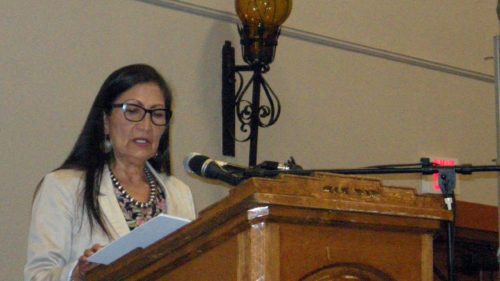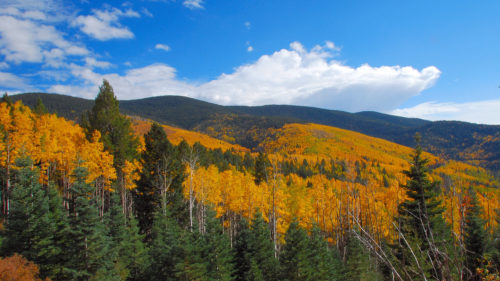New Mexico has long been a mecca for public land hunters and anglers. Since becoming a state in 1912, the Land of Enchantment has offered sportsmen and women unparalleled opportunity to pursue world-class elk, mule deer and other big game; to fish cold, clear mountain streams for native trout; to chase a variety of upland game as summer turns to fall – all on lands owned by every American.
And with the recent designations of national monuments spanning some of the best hunting and fishing areas in northern and southern New Mexico, future generations can be guaranteed that the same opportunities for quality outdoor time will exist in perpetuity.
New Mexico is blessed with more than 20 million acres of mountain forests, rolling piñon-juniper foothills and sagebrush desert owned by and open to the public. A substantial portion of that acreage is part of the National Conservation Lands system, which was created in 2000 to permanently protect the best lands held by the Bureau of Land Management (BLM).
These conservation lands, which include less than 15 percent of all BLM holdings, were set aside for their nationally significant recreation, wildlife, ecological, cultural and scientific values. Hunters and anglers nationwide have been among the driving forces for protecting the National Conservation Lands to ensure that future generations of sportsmen and women have quality places to pursue fish and game.
One of the newest additions to the National Conservation Lands system – and among the best areas to fish or hunt in northern New Mexico – is Rio Grande del Norte National Monument. Established by executive order in 2013, the monument covers almost 250,000 acres of peaks, plains and rushing river. It stretches from San Antonio Mountain on its western side to Ute Mountain on the east, and from the Colorado border to a point just south of Taos.
Much of the monument encompasses the Taos Plateau, with its long vistas of volcanic peaks fringed by pine forest and surrounded by grassy plains. But its best-known geographic feature is a 74-mile stretch of the Rio Grande and the 800-foot-deep gorge the river has cut through the black lava landscape. Designated as a National Wild and Scenic River, the fishing on this stretch of the Rio Grande is some of the best in New Mexico, where anglers can hook into native cutthroat, brown and rainbow trout that occasionally top 20 inches.
There is good trout fishing in the Gorge nearly year-round, and, for variety, pike and smallmouth bass. But a key element is the river’s flow rate. The best fishing will occur in those periods before and after the spring runoff spikes, and again in the fall, from September into mid-November.
One major event every year on the Upper Rio Grande is the caddis hatch, which can start in early April and last a month or more. Because the water is still cool, fish in the late afternoon or even early evening using a typical dry/dropper combination.
Fishing the Rio Grande Gorge, however, is not for the faint of heart nor the out of shape. It requires a long, steep hike from the rim, the canyon floor is strewn with massive, river-rounded boulders, the weather can change in a heartbeat and the water itself is fast, deep and cold. Anglers unfamiliar with the Gorge should talk to one of the fly-fishing shops or guide services in Taos for more information or help navigating this world-class fishing opportunity.
Those who don’t want to trek down into the Gorge have options, too. There are good roads down to the river at John Dunn Bridge (located north of Taos, below the town of Arroyo Hondo) or farther south at the village of Pilar. Cast from shore and you may hook the fish of a lifetime.
While other areas of New Mexico are well-known for their massive elk, the Rio Grande del Norte region consistently yields 6×6 and larger bulls, not to mention mule deer in the 200” plus class, pronghorn antelope, black bear and bighorn sheep. And although experienced hunters will happily show you photos of their successful hunts, they’re not likely to tell you where to go – one cagey sportsman who recently harvested a 30-1/2-inch-wide, 225-inch muley buck would say only that he shot the animal “on or near” the Monument.
But big game is not the only game in Rio Grande del Norte National Monument and the surrounding public lands managed by the BLM and the U.S. Forest Service. Turkey hunters can buy a $25 license over the counter, and will find plenty of good habitat in the area to chase spring gobblers. A fall season license is also available over-the-counter, but with a harvest limit of one turkey of either sex. Check with NMDGF for details.
Black bear hunters can buy a license over the counter for hunts that start in mid-August and run through mid-November. Bear hunting is managed by zone, rather than by Game Management Unit. To maintain healthy bear populations, each zone can be closed to hunting once the overall limit is achieved or a separate limit on the harvest of females is reached. Again, check with NMDGF.
And upland game season offers additional hunting opportunity for quail in Organ Mountains Desert Peaks National Monument.
With all that opportunity to hunt and fish in the Rio Grande del Norte region, it should come as no surprise that hunters and anglers were among the many individuals and organizations that worked together to permanently protect the area through a National Monument designation. Their broad coalition was crucial to the designation effort, former NMWF Sportsmen’s Coordinator Max Trujillo said at the time.
“This was an excellent example of how a region came together to protect an area that represents both the past and the future,” Trujillo said. “There are families that have been here for 300 years, hunting, fishing, grazing their livestock and gathering herbs and pinon. There also are families who have started businesses that rely on clean water and healthy landscapes. This designation ensures that the traditional lifestyle can carry on and that our outdoor recreation opportunity and economy will continue to benefit northern New Mexico.”
A similar coalition also was successful at the opposite end of the state, where sportsmen and women joined an effort to support creation of Organ Mountains-Desert Peaks National Monument in 2014. Spanning nearly 500,000 acres, the new Monument provides permanent protection for a suite of landscapes that southern New Mexico groups and individuals deemed too valuable to lose.
Hunters were among the earliest to call for protecting thousands of acres of BLM land around Las Cruces, which they had traditionally used for generations. The low-lying ranges of the West Potrillo Mountains, the Robledos Mountains and the Sierra de Las Uvas hold small numbers of mule deer and javelina, but the arid landscape is a limiting factor for wildlife and hunting pressure is light.
Longtime local hunters and Monument advocates like Jim Bates of Las Cruces say their primary interest is upland game – dove and quail seasons provide an opportunity to hunt just a short drive from the state’s second-largest city. Check with NMDGF for specific quail dates and bag limits.
The Monument protects a large swath of Chihuahuan Desert grasslands, along with rolling hills dotted with pinon and juniper and the “sky island” canyons of the Organ Mountains – sharp peaks on the eastern flank of Las Cruces that rise nearly a mile above the Rio Grande, to almost 9,000 feet. The entire area is an important biological link between northern Mexico and the greater Southwest that provides long-term protection for a variety of wildlife.
But human history is also a major part of the story for Organ Mountains-Desert Peaks National Monument. Within the Monument’s folds, canyons and flatlands are remnants of New Mexico’s past, from thousands of ancient petroglyphs reflecting prehistoric life, to traces of the Butterfield Overland Mail Route, which carried U.S. mail from St. Louis to San Francisco, to the bulldozer-carved targets in a secret World War II bombing range used to develop the famous Norden bomb sight.
Unfortunately, these two monuments – both of which were decades in the making and which developed strong local support – are threatened by the report from President Trump’s executive order to “review” more than two dozen national monuments nationwide. It remains to be seen whether any president has the legal authority to reverse or amend previous presidents’ monument decisions. But sportsmen and women who appreciate the hunting and fishing opportunities these monuments provide should be prepared to speak up in support of them in the future, because their future is cloudy.



